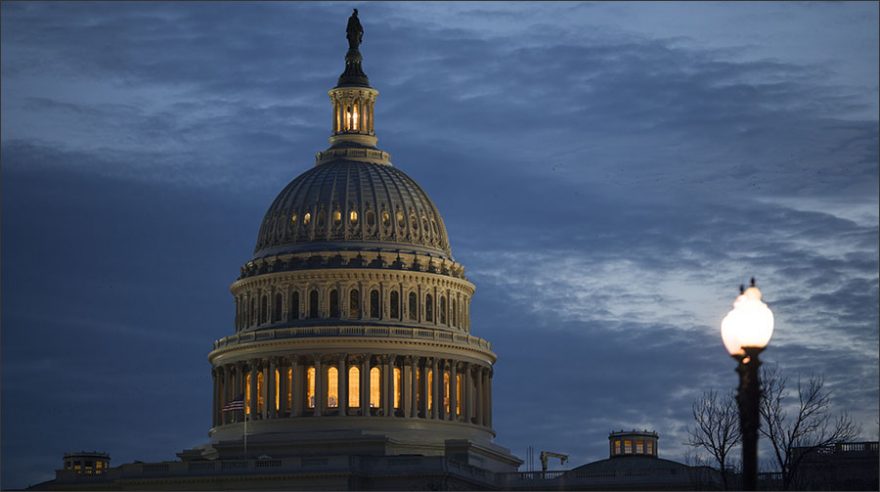Congress Debates New Stimulus, With Money for Education – and Potentially Broadband – In Mind

UPDATED
Education funding is a major focus of the next coronavirus stimulus package, though it remains to be determined how much it will support key state and local priorities around remote or in-person instruction, or provide new money for increased high-speed internet access.
A legislative draft circulating among lawmakers envisions $70 billion for K-12, $30 billion of which would be distributed to states for K-12 in general, and another $30 billion to be reserved only for schools that hold in-person classes, as Education Week’s Andrew Ujifusa reported. The latter $30 billion would be contingent on districts having a reopening plan.
Treasury Secretary Steven Mnuchin has said that education is one of three top priorities for the in-progress stimulus package.
The Senate on Monday released the text of its legislative proposal for the next coronavirus stimulus package, which includes no allocation for increased K-12 broadband funding, a major topic of interest for the education community.
The House in May passed a coronavirus relief bill that subsequently died in the Senate. That legislation, the HEROES Act, proposed to create a $90 billion state fiscal stabilization fund for the U.S. Department of Education to support K-12 and higher education.
While the specifics of the current legislation are being hammered out by the Trump administration and Senate GOP, the Republican-controlled Senate and Democrat-controlled House would have to resolve any differences they have before final legislation can be sent to President Donald Trump for signature.
For one, Democrats have publicly rejected the idea of conditioning federal virus aid to schools reopening with in-person learning.
Education companies across the market typically count heavily on districts having federal funding available to them to buy products, in areas such as curriculum, professional development, classroom assessment, and social-emotional learning. Federal money has become especially important during COVID-19, given the shaky financial footing in school districts, and projections of deep cuts in state funding.
Broadband funding—especially the prospect of using E-rate to help underserved students study from home—has been a point of contention between congressional Democrats and the Trump administration.
E-rate is a major program overseen by the FCC that supports improved internet access in schools and libraries. E-rate funding is capped at about $4.15 billion annually.
House and Senate Democrats have called for the Federal Communications Commission to use its emergency powers to issue a policy allowing for E-rate funds to support at-home learning during the pandemic. The Communications Act states that funds must be used for equipment located only in K-12 school buildings.
Because that language is written in law, FCC Chairman Ajit Pai has said he believes that Congress must pass new legislation to change the applicable statutory language.
The push for new federal support for broadband comes as many school districts across the country have announced they will be relying on remote learning, rather than in-person instruction, this fall because of concerns about COVID-19. At the same time, many school officials have voiced worries about remote learning worsening inequities, because of students lacking access to either devices or reliable connectivity at home.
“I’ll be really interested to see what, if any, the Senate Republican bill does on that front to invest in the homework gap,” said Reg Leichty, a founding partner of education consultancy Foresight Law+Policy, who lobbies for K-12 interests including equity promotion. “It just doesn’t make sense to go into this next school year having not taken some steps at the federal level.”
Competing Needs
Sarah Abernathy, deputy executive director of the Committee for Education Funding, an advocacy group that lobbies for increasing federal investments in education, said she expects the upcoming stimulus to address broadband because the digital divide is such a big issue, though it’s unclear just what form the funding might take.
“I don’t think it’ll be the most controversial part of the education funding proposals, and I think that there’s been some fairly widespread support for increased broadband access,” she said.
One action potentially pointing to at least some bipartisan support for increasing students’ remote broadband access came during last month’s release of The Broadband Connectivity and Digital Equity Framework by Senate Commerce Committee Chairman Roger Wicker, R-Miss., and House Energy and Commerce Committee ranking member Greg Walden. R-Ore.
One tenet of the list of proposals, which is meant to serve as a basis for COVID-19 economic recovery legislation, is to ensure students can access broadband and necessary technology to “complete their homework remotely.”
Congress could hypothetically pass language providing a separate funding stream for K-12 broadband in addition to E-rate, according to Abernathy.
Outside of broadband, the bill will likely provide some support for ed tech, as school districts that are switching to all-remote or hybrid learning models will look toward digital learning software as a way to fill some education gaps.
Any money that goes into the education pipeline as a result of the stimulus will help support teacher pay and equipment and infrastructure to address public health concerns in schools, Abernathy said.
“A lot of the money is going to end up being used for things to make schools safe as well as to provide education in whatever form it’s going to be provided this fall,” she said.
The Senate bill unveiled Monday would give $70 billion to K-12 public and private schools, as well as $5 billion for governors to use on K-12 and higher education.
According to the bill text, allowable expenditures include purchasing ed tech for students, including low-income students and students with disabilities, which may include assistive technology or adaptive equipment.
Follow EdWeek Market Brief on Twitter @EdMarketBrief or connect with us on LinkedIn.
Image by iStock/Getty Images Plus.
See also:

does chloroquine work https://chloroquineorigin.com/# hydroxychloroquine what is it